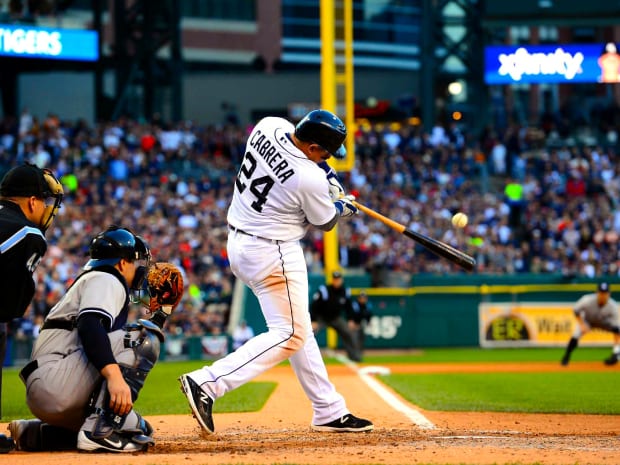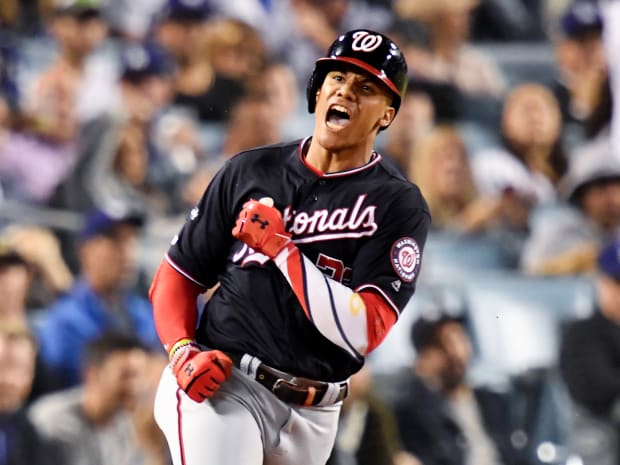There hasn't been anyone like him since Aaron and Mays. Is this young star going to be his successor?
Welcome to The Opener, where every weekday morning you’ll get a fresh, topical column to start your day from one of SI.com’s MLB writers.
Simplicity endures. The three greatest legacy hitting milestones are the ones that need no context, explanation or acronym: 500 home runs, 3,000 hits and a .300 batting average. Only two players ever reached all three: Henry Aaron and Willie Mays. Miguel Cabrera is about to join them. Nothing better frames the genius of Cabrera’s hitting than belonging in such elite company.
It has been 51 years since Aaron and Mays recorded their 3,000th hit. Since then, 22 players have reached 3,000 hits, 19 have reached 500 home runs and 48 have batted .300 over at least 1,000 games. With 39 more hits, only Cabrera, a career .311 hitter, will have checked all three boxes. In a half century of baseball, he is one of one.

Al Tielemans/Sports Illustrated
The roots of such a historic, complete hitter trace to when he was 7 years old in Venezuela. Cabrera told me this story in 2010 when I wondered how he became such a great pure hitter, especially with the rare skill of hitting the ball to the opposite field with power. One of his uncles would throw batting practice to little Miguel, who like most kids loved to hit a lot more than he liked to run.
“He said, ‘Hit the ball the other way,’” Cabrera told me. “‘Every time you pull the ball you have to run a lap.’ So I hit the ball the other way.”
Thirty-one years later, Cabrera hit his 500th home run with that signature power swing to the opposite field. The only surprise was that he hit a Steven Matz changeup. It was the first time in four years he hit an off-speed pitch for an opposite-field home run. Cabrera’s default approach is to hammer fastballs the other way and pull off-speed and breaking pitches, a sublime approach that almost never leaves him off balance. He has recorded 21% of his career hits to the opposite field.
How long will it take for another Cabrera to come along—someone like Aaron and Mays who can hit for power and average by using the whole field? The answer may have been provided in the Nationals clubhouse after Game 1 of the 2019 World Series. Nats vice president of international operations Johnny DiPuglia was asked about Juan Soto, whose 417-foot homer that night is still the second longest Gerrit Cole has ever allowed to the opposite field on his signature high fastball.
“Mr. Lerner keeps asking me when am I going to find another Soto,” DiPuglia said, referring to the team’s owner. “I tell him, ‘Guys like this come along once every 50 years.’”
Soto, 22, has played just 431 major league games. It’s early, but he has the best chance of any player today of being the next Miguel Cabrera.
Start with this: finding .300 hitters in today’s game is difficult. At .296, Soto ranks among the four highest-average active hitters 29 and younger with at least 400 games.
Highest Career Average, Active Hitters 29 & Younger (min. 400 games)
Trout, Turner and Betts don’t hit the ball the other way like Soto, a trait that allows a hitter to age well. Soto’s career opposite-field hit percentage is the same as the one for Cabrera. That’s not all they have in common. The starts to their career are similar:
First 431 Games
Their hit direction is similar:
Career Hitting by Direction
And how about this: comparing Soto’s first 91 home runs to Cabrera’s last 91 home runs:
Past 91 Home Runs by Direction
When you break down those homers by pitch velocity, you see they have a similar approach: pull the slower pitches, let velocity get deep in the hitting zone:
Past 91 Home Runs by Average Pitch Velocity
Jim Leyland, one of Cabrera’s former managers, once told me that Cabrera had “the best opposite-field power of any player I’ve ever seen.” Soto has even more opposite field power. Since Soto debuted on May 20, 2018, he has hit more opposite field homers than any hitter in baseball—34, three more than Aaron Judge and J.D. Martinez.
Judge is the new king of opposite-field power. He slugs .960 when he hits the ball the other way, easily the best among active players with at least 90 opposite-field hits, ahead of Soto (.819) and Rafael Devers (.793).
Judge, 29, is seven years older than Soto and a career .279 hitter. Soto is one of the best young hitters the game ever has seen. He will become one of only five hitters with three qualified seasons with an OPS better than .900 through age 22, joining Mel Ott, Jimmie Fox, Ted Williams and Trout. With a month still to play, he already joined Ott and Williams as the only players with 100 walks and 20 homers in two seasons by age 22.
Like Williams, Soto has what seems to be a preternatural command of the strike zone. He swings at pitches outside the strike zone less than any hitter in baseball (12.8%), a phenomenal trait for a 22-year-old. He is the only player in the majors with more walks than strikeouts.
His discipline is even more impressive after the Nationals traded Trea Turner, Kyle Schwarber, Yan Gomes and Josh Harrison at the deadline, removing much of his veteran help in the Washington lineup. Before the deadline Soto saw 49% of his pitches in the strike zone. Since the deadline it has dropped to 45%. He leads the league in intentional walks—for the second straight year. He walked 28 times in his first 21 games after the deadline. His OBP this month is .467.

Robert Hanashiro/USA TODAY Sports
Last week on a Zoom conference Soto was asked if he were growing weary of so many walks. He told reporters, “I mean, I prefer a walk than strikeouts, so I like it. I like it. Every time I take a walk I don’t mind it at all, even if they intentionally walk me.”
Soto’s batting eye and Cabrera-like approach of hitting velocity to the opposite field should serve him well as he ages. Albert Pujols (.297 career, .266 after 30), Alex Rodriguez (.295, .278), Rafael Palmeiro (.288, .282) and Eddie Murray (.287, .278) all fell short of checking the .300 career box. All relied on pulling the ball more than Cabrera and Soto.
Aaron (.292 after 30), Mays (.290) and Cabrera (.300) had swings and approaches that held up well as they aged. Their careers are especially impressive when you consider that either Aaron, Mays or Cabrera played in the 14 most difficult seasons in which to get a hit in the Live Ball Era (since 1920): 1963-69, 1972, 1977, 2014, 2018-21.
Now think about what that means for Soto. Before he made his debut in 2018, there had been only 10 seasons in 100 years in which the MLB batting average was .252 or worse. It has happened all four seasons since—the first such stretch since the mound was lowered in 1969. He stepped into the worst hitting environment … and is thriving at historic levels.
More MLB Coverage:
• Miguel Cabrera's Swing Stands Up to Father Time
• Max Scherzer Is Showing the Padres What They’re Still Missing
• Wander Franco's First Breakout Is Happening Before Our Eyes
• The Rays Are Winning Efficiently, but at What Cost?
No comments:
Post a Comment